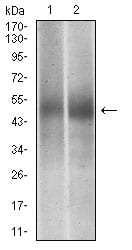
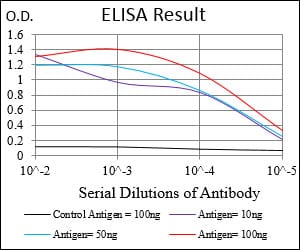
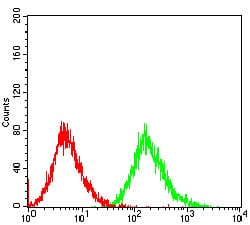
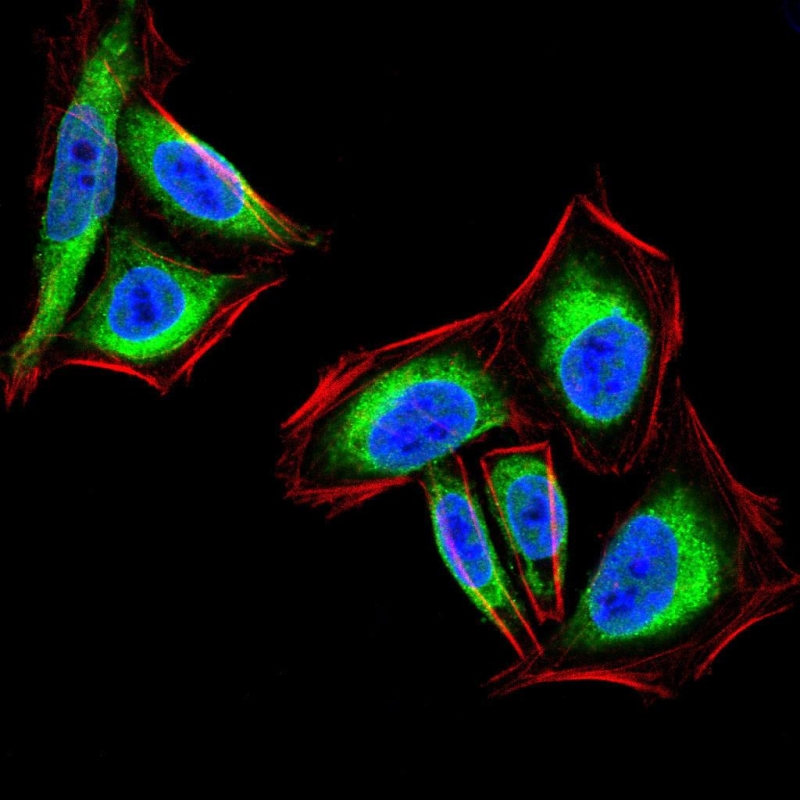
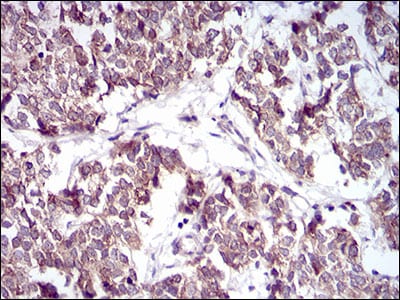
| WB | 1/500 - 1/2000 | Human,Mouse,Rat |
| IF | 咨询技术 | Human,Mouse,Rat |
| IHC | 1/200 - 1/1000 | Human,Mouse,Rat |
| ICC | 1/200 - 1/1000 | Human,Mouse,Rat |
| FCM | 1/200 - 1/400 | Human,Mouse,Rat |
| Elisa | 1/10000 | Human,Mouse,Rat |
| Aliases | PTP1B |
| Entrez GeneID | 5770 |
| clone | 4F8F11 |
| WB Predicted band size | 50kDa |
| Host/Isotype | Mouse IgG1 |
| Antibody Type | Primary antibody |
| Storage | Store at 4°C short term. Aliquot and store at -20°C long term. Avoid freeze/thaw cycles. |
| Species Reactivity | Human |
| Immunogen | Purified recombinant fragment of human PTPN1 (AA: 40-246) expressed in E. Coli. |
| Formulation | Purified antibody in PBS with 0.05% sodium azide. |
+ +
以下是3篇与PTPN1抗体相关的文献摘要信息,按研究领域分类整理:
---
### 1. **代谢疾病研究**
**文献名称**:*Increased insulin sensitivity and obesity resistance in mice lacking the protein tyrosine phosphatase-1B gene*
**作者**:Elchebly, M. et al.
**摘要**:
本研究利用PTPN1基因敲除小鼠模型,通过Western blot和免疫沉淀(使用PTPN1特异性抗体)证实PTP1B蛋白缺失。结果显示,敲除小鼠在胰岛素敏感性显著提高且抵抗饮食诱导的肥胖,为PTP1B作为糖尿病治疗靶点提供依据。
---
### 2. **癌症机制研究**
**文献名称**:*Protein tyrosine phosphatase 1B (PTP1B) promotes oncogene-driven glioblastoma initiation via regulation of ROS production*
**作者**:Wiencke, J.K. et al.
**摘要**:
通过免疫组化(使用抗PTPN1抗体)分析胶质母细胞瘤样本,发现PTP1B高表达与肿瘤进展相关。实验表明PTP1B通过调控活性氧(ROS)促进癌基因驱动的肿瘤发生,提示其作为癌症治疗潜在靶点。
---
### 3. **药物开发应用**
**文献名称**:*Allosteric inhibition of PTP1B by a novel derivative of trodusquemine improves glucose homeostasis in diabetic mice*
**作者**:Krishnan, N. et al.
**摘要**:
研究开发了一种新型PTP1B变构抑制剂,使用PTPN1抗体进行Western blot和免疫荧光验证药物对肝脏组织中PTP1B活性的抑制效果。结果显示该化合物显著改善糖尿病小鼠的血糖稳态。
---
### 可选补充(经典研究)
**文献名称**:*Neuronal PTP1B regulates body weight through adipocyte insulin signaling*
**作者**:Bence, K.K. et al.
**摘要**:
通过特异性敲除小鼠神经元中的PTPN1基因,结合免疫印迹(抗PTPN1抗体)发现,神经元PTP1B通过调控脂肪细胞胰岛素信号通路影响能量代谢,揭示了其在肥胖中的神经调控机制。
---
**说明**:以上文献均涉及PTPN1抗体的实验应用(如Western blot、免疫组化等),涵盖代谢疾病、癌症及药物开发领域,提供机制与治疗角度的参考。
The protein tyrosine phosphatase non-receptor type 1 (PTPN1), also known as PTP1B, is encoded by the PTPN1 gene and belongs to the protein tyrosine phosphatase (PTP) family. It plays a critical role in regulating cellular signaling by dephosphorylating tyrosine residues on target proteins, thereby modulating processes such as cell growth, differentiation, and metabolism. PTPN1 is a key negative regulator of insulin and leptin signaling pathways, making it a significant focus in metabolic disorders like diabetes and obesity. Its dysregulation has also been implicated in cancer, inflammation, and neurodegenerative diseases.
PTPN1 antibodies are essential tools for detecting and quantifying PTPN1 expression in various experimental settings, including Western blotting, immunohistochemistry, and immunofluorescence. These antibodies help elucidate the protein's localization, expression levels, and interactions in cellular pathways. Researchers use them to study PTPN1's role in disease mechanisms, particularly its involvement in insulin resistance, oncogenic signaling, and immune response modulation. Due to its therapeutic potential, PTPN1 is explored as a drug target, with inhibitors under investigation for treating metabolic syndromes and cancers. Antibodies specific to PTPN1 thus support both basic research and drug development by enabling precise detection and functional analysis. Their validation for specificity, sensitivity, and cross-reactivity is crucial for ensuring experimental reliability across diverse biological samples.
×